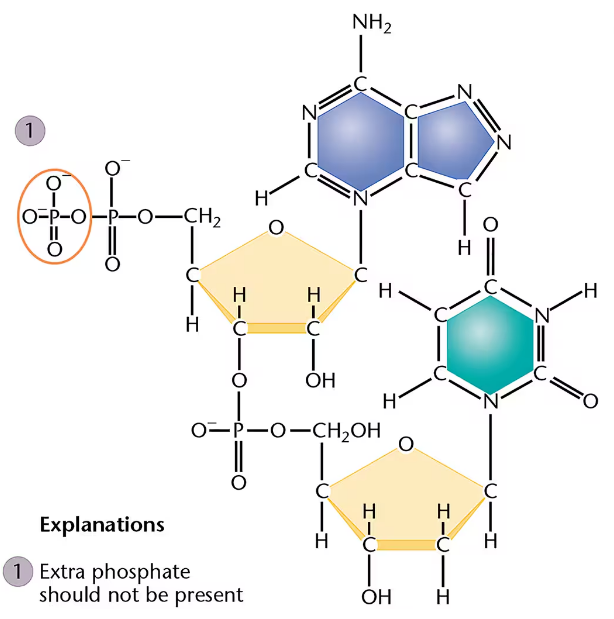 Back
BackProblem 1a
How were scientists able to determine that DNA, and not some other molecule, serves as the genetic material in bacteria and bacteriophages?
Problem 1b
How do we know that DNA also serves as the genetic material in eukaryotes such as humans?
Problem 1c
How was it determined that the structure of DNA is a double helix with the two strands held together by hydrogen bonds formed between complementary nitrogenous bases?
Problem 1d
How do we know that G pairs with C and that A pairs with T as complementary base pairs are formed?
Problem 2
Most center around DNA and RNA and their role of serving as the genetic material. Write a short essay that contrasts these molecules, including a comparison of advantages conferred by their structure that each of them has over the other in serving in this role.
Problem 3
Discuss the reasons proteins were generally favored over DNA as the genetic material before 1940. What was the role of the tetranucleotide hypothesis in this controversy?
Problem 4
Contrast the contributions made to an understanding of transformation by Griffith and by Avery and his colleagues.
Problem 5
When Avery and his colleagues had obtained what was concluded to be the transforming factor from the IIIS virulent cells, they treated the fraction with proteases, RNase, and DNase, followed in each case by the assay for retention or loss of transforming ability. What were the purpose and results of these experiments? What conclusions were drawn?
Problem 6
Why were ³²P and ³⁵S chosen for use in the Hershey–Chase experiment? Discuss the rationale and conclusions of this experiment.
Problem 7
Does the design of the Hershey–Chase experiment distinguish between DNA and RNA as the molecule serving as the genetic material? Why or why not?
Problem 8
What observations are consistent with the conclusion that DNA serves as the genetic material in eukaryotes? List and discuss them.
Problem 9
What are the exceptions to the general rule that DNA is the genetic material in all organisms? What evidence supports these exceptions?
Problem 10
Draw the chemical structure of the three components of a nucleotide, and then link the three together. What atoms are removed from the structures when the linkages are formed?
Problem 11
How are the carbon and nitrogen atoms of the sugars, purines, and pyrimidines numbered?
Problem 12
Adenine may also be named 6-amino purine. How would you name the other four nitrogenous bases, using this alternative system? (O is indicated by 'oxy-,' and CH₃ by 'methyl.')
Problem 13
Draw the chemical structure of a dinucleotide composed of A and G. Opposite this structure, draw the dinucleotide composed of T and C in an antiparallel (or upside-down) fashion. Form the possible hydrogen bonds.
Problem 14
Describe the various characteristics of the Watson–Crick double-helix model for DNA.
Problem 15
What evidence did Watson and Crick have at their disposal in 1953? What was their approach in arriving at the structure of DNA?
Problem 16
What might Watson and Crick have concluded had Chargaff's data from a single source indicated the following?
Why would this conclusion be contradictory to Wilkins's and Franklin's data?
Problem 17
How do covalent bonds differ from hydrogen bonds? Define base complementarity.
Problem 18
List three main differences between DNA and RNA.
Problem 19
What are the three major types of RNA molecules? How is each related to the concept of information flow?
Problem 20
How is the absorption of ultraviolet light by DNA and RNA important in the analysis of nucleic acids?
Problem 21
What is the physical state of DNA after it is heated and denatured?
Problem 22
What is the hyperchromic effect? How is it measured? What does Tₘ imply?
Problem 23
Why is Tₘ related to base composition?
Problem 24
What is the chemical basis of molecular hybridization?
Problem 25
What did the Watson–Crick model suggest about the replication of DNA?
Problem 26
A genetics student was asked to draw the chemical structure of an adenine- and thymine-containing dinucleotide derived from DNA. The answer is shown here:
The student made more than six major errors. One of them is circled, numbered 1, and explained. Find five others. Circle them, number them 2 through 6, and briefly explain each in the manner of the example given.
Problem 27
Considering the information on B- and Z-DNA and right- and left-handed helices, carefully analyze structures (a) and (b) below and draw conclusions about their helical nature. Which is right-handed and which is left-handed?


